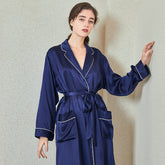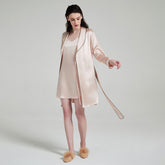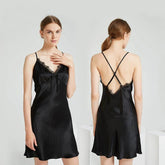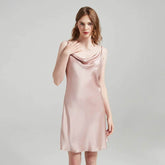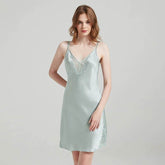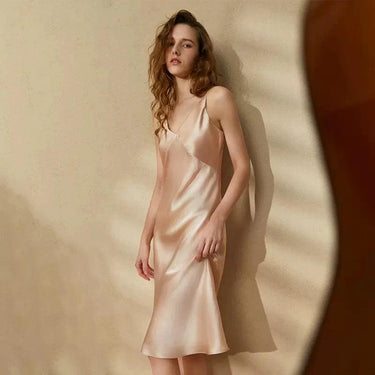Pink Silk Pajamas Set: Luxury Sleepwear Collections for Every Season
The Timeless Appeal of Pink Silk Pajamas
Silk stands as one of history's most prized textiles, revered across civilizations for its unmatched luster and remarkable touch. This natural fiber, first cultivated in ancient China over 5,000 years ago, remains the standard for luxury fabric. Pink silk pajamas represent the perfect marriage of this storied material with a color that embodies both sophistication and tranquility. The rose-tinted sleepwear transforms ordinary rest into a nightly ritual of elegance.
The connection between quality sleep and premium fabrics continues to strengthen as research confirms how materials affect rest. Pink silk pajamas deliver not just visual charm but tangible benefits that improve sleep quality and skin health. These garments bridge the gap between functional sleepwear and cherished personal investment.
This comprehensive guide explores the world of pink silk sleepwear collections – examining the science behind silk, color psychology of pink tones, seasonal versatility, craftsmanship markers, and practical care insights that ensure your investment delivers lasting value through every season.

Understanding Silk: What Makes It Special?
Mulberry silk stands separate from other silk varieties thanks to its unique origin. Harvested from Bombyx mori silkworms that feed exclusively on mulberry leaves, this premium silk features remarkably consistent fibers that create an unmatched smooth texture. These natural protein fibers contain 18 amino acids and natural elements that benefit skin cell metabolism.
The material's natural temperature regulation capabilities make it truly exceptional. Silk adjusts to body temperature, providing cooling comfort during summer nights when thermometers climb above 75°F (24°C) while offering insulation during winter when temperatures drop below 65°F (18°C). This natural thermoregulation occurs because silk fibers create micro-pockets that trap air, creating natural insulation that cotton or synthetic materials cannot match.
Unlike cotton, which absorbs moisture at 27% of its weight, silk wicks moisture at just 11%, keeping sleepers drier throughout the night. This reduced moisture absorption also prevents the fabric from harboring common allergens like dust mites or fungal spores, making silk pajamas ideal for those with sensitive skin or respiratory concerns.
The fiber structure itself explains silk's distinctive feel. Mulberry silk fibers measure approximately 25-30 microns in diameter (compared to cotton's 50-60 microns), creating a lighter material that still resists wear. This natural protein structure also means silk contains sericin, a protein that shares amino acid properties with human skin, contributing to its hypoallergenic profile and reputation as "skin-friendly" fabric.

Shades of Pink: Choosing the Perfect Hue
The spectrum of pink in silk pajamas offers variety that extends beyond simple color preference, with each shade creating distinct visual and psychological effects. Blush pink, with its subtle warmth and neutral undertones, presents a versatile option that complements most skin tones while providing understated elegance. Rose pink introduces more vibrant energy while maintaining sophistication through its deeper saturation. Powder pink delivers classic femininity with cooler undertones that particularly flatter those with olive or cool skin tones.
Selecting the most flattering pink shade depends largely on underlying skin tones. Those with warm undertones (yellow, peach, or golden skin) find harmony in peach-pink or salmon shades that echo their natural warmth. Cool undertones (pink, red, or bluish skin) pair beautifully with rose, fuchsia, or mauve selections that balance rather than compete with natural coloring. Neutral undertones enjoy the most flexibility, though pure rose pinks often provide exceptional complementary effects.
The psychological impact of pink extends beyond aesthetics into measurable effects on relaxation. Research published in the Journal of Orthomolecular Medicine found exposure to pink environments can reduce stress hormone production and lower blood pressure. This makes pink silk pajamas particularly effective for creating sleep-conducive environments, as the color encourages parasympathetic nervous system activation – the body's "rest and digest" mode – which facilitates deeper, more restorative sleep cycles.

Style Options for Pink Silk Pajamas
The classic button-up pink silk pajama set represents timeless luxury with its structured collar, full-length sleeves, and matching pants. This traditional design often features contrast piping that defines edges while showcasing the garment's tailoring precision. The structured nature of these sets provides modest coverage while maintaining elegant drape thanks to silk's natural weight.
For warmer nights, camisole-and-shorts combinations offer greater breathability while preserving silk's benefits against skin. These sets typically feature adjustable straps and elastic waistbands that enhance comfort without compromising the fabric's natural movement. Many premium options include French seams that eliminate rough edges against sensitive skin while extending the garment's durability.
Vintage-inspired nightgowns merge contemporary comfort with classic silhouettes, often featuring delicate details like subtle gathers, covered buttons, or ribbon accents. These single-piece designs maximize skin contact with silk, expanding the fabric's benefits across more surface area.
Complementary silk robes extend the sleep ensemble, providing transitional wear that bridges private sleep moments and household visibility. Short kimono styles offer practical coverage while longer variants create dramatic silhouettes that emphasize silk's natural flow and light-capturing properties.
Detail variations significantly influence both function and aesthetic appeal in pink silk pajamas. Contrast piping creates visual definition while reinforcing structural elements. Lace trim introduces textural contrast, with premium sets featuring hand-applied French Chantilly or Leavers lace. Embroidered elements – particularly tone-on-tone techniques – add subtle dimension without disrupting silk's natural drape or comfort against skin.

Seasonal Adaptability: Silk Pajamas for Every Climate
Silk's remarkable natural properties make it uniquely suited for year-round wear, with strategic weight variations enhancing its performance across seasons. During summer months when temperatures exceed 75°F (24°C), lightweight silk pajamas in the 16-19 momme range prove ideal. These lighter constructions maximize silk's moisture-wicking properties, drawing perspiration away from the body at approximately twice the efficiency of cotton. This lightweight silk still provides 40% more UV protection than cotton alternatives, addressing both comfort and skin protection concerns during peak sunlight months.
Winter conditions call for heavier silk constructions in the 22-25 momme range. These denser weaves retain body heat through improved insulation while maintaining breathability that prevents overheating. The thermal efficiency of these heavier silks delivers warmth comparable to materials weighing nearly twice as much, eliminating the bulk associated with traditional winter sleepwear while providing equivalent warmth in temperatures below 50°F (10°C).
Spring and fall transitional seasons benefit from mid-weight silk pajamas (19-22 momme) that offer versatility during temperature fluctuations. These balanced constructions provide appropriate insulation during cooler evenings while preventing overheating as temperatures rise. Many premium collections feature adjustable elements like roll-up sleeves or convertible necklines that enhance this adaptability through simple modifications rather than complete garment changes.
The cut and style of seasonal silk pajamas also reflect practical adaptations. Summer collections often feature shorter sleeves, wider leg openings, and strategic venting that maximizes airflow. Winter variations introduce longer sleeves, covered buttons that prevent cold metal contact with skin, and sometimes subtle weight variations within the same garment – placing heavier silk in core body areas while using lighter constructions in areas prone to overheating.

Craftsmanship and Quality Indicators
Momme weight serves as the definitive measurement of silk quality, indicating the fabric's density by measuring the weight of 100 yards of silk that measures 45 inches wide. Premium sleepwear typically ranges from 16-25 momme, with higher numbers indicating denser, more durable silk that often provides enhanced opacity and structure. While lighter weights offer sublime softness for summer wear, higher momme counts (22-25) ensure exceptional durability that withstands years of wear and washing.
The construction methods employed in pink silk pajamas dramatically influence both comfort and longevity. French seams represent the gold standard in silk garment construction, encasing raw edges within the seam itself to eliminate potential irritation points and prevent fraying even through repeated washing. This technique requires nearly twice the labor of standard seams but extends garment life by years rather than seasons.
Mother-of-pearl buttons serve as both functional elements and markers of premium construction. These natural shell buttons maintain consistent temperature against skin unlike metal or plastic alternatives, while their unique luster complements silk's natural sheen. The smooth edges prevent thread abrasion during washing, dramatically reducing a common failure point in lower-quality sleepwear.
Hand-finished edges distinguish luxury silk pajamas through techniques like hand-rolled hems that create nearly invisible transitions along fabric edges. This labor-intensive process involves minute stitches that secure the fabric without creating the ridge associated with machine finishing, preserving the garment's drape while enhancing durability at vulnerable points.
When evaluating silk pajama quality, examine these additional indicators: pattern matching at seams (particularly noticeable on piping or prints), selvedge utilization that incorporates the fabric's finished edge into construction, and color consistency across pattern pieces that confirms single-dye-lot production rather than mass manufacturing.

Benefits Beyond Comfort
The protein structure of silk delivers skin benefits that extend far beyond simple comfort. The natural amino acids in silk match skin's own profile, creating biomimetic effects that support skin cell metabolism. Research published in the International Journal of Tissue Reactions demonstrates silk's ability to minimize transepidermal water loss by up to 30% compared to cotton fabrics, helping skin maintain optimal hydration levels throughout sleep cycles.
The friction coefficient of premium silk measures just 7.4% – significantly lower than cotton (30%) and synthetic satin (15%). This minimal friction prevents sleep creases and reduces physical stress on facial skin that contributes to premature aging. Dermatologists note that this reduced friction proves particularly beneficial for active sleepers who change positions frequently during rest.
Hair health improves through similar mechanisms, as silk's smooth surface prevents the cuticle damage common with cotton pillowcases. Our silk pillowcases provide these same benefits for complete hair protection during sleep. The fabric's moisture management capabilities help maintain optimal scalp conditions by wicking excess oil while preventing overdrying. Studies demonstrate reduced hair breakage rates by up to 43% among consistent silk pillowcase users, with particularly notable benefits for those with fine or color-treated hair.
The hypoallergenic properties of silk stem from multiple natural characteristics. The tight weave of silk fibers creates physical barriers against common allergens like dust mites, which cannot penetrate the dense structure. Additionally, the protein sericin found naturally in silk demonstrates mild antimicrobial properties that discourage bacterial growth – a significant advantage for those with acne-prone or sensitive skin.
These benefits accumulate over time, making silk pajamas an investment in both immediate comfort and long-term wellness. The durability of properly maintained silk sleepwear extends these advantages, with quality pieces often remaining serviceable for 5-10 years compared to cotton's typical 2-3 year lifespan.

How to Choose the Perfect Pair
Selecting ideal pink silk pajamas requires consideration of both physical fit and personal use patterns. Accurate measurements prove essential since silk lacks the stretch forgiveness of synthetic materials. Measure bust or chest at the fullest point, waist at the natural indentation, and hips at their widest circumference. Allow approximately 1-2 inches (2.5-5 cm) of ease beyond body measurements for optimal comfort without sacrificing silk's natural drape.
Style preferences should reflect sleep behaviors. Active sleepers benefit from secure closures and sufficient range of motion, while still sleepers might prioritize design elements. Consider neckline variations – notched collars offer classic styling but may create pressure points for side sleepers, while scoop or V-neck alternatives eliminate this concern while maintaining elegance.
Seasonal needs dictate appropriate weight selection. Beyond the momme considerations discussed earlier, examine garment construction details that enhance temperature regulation. Sleeve length, pant design, and closure types significantly impact heat retention or release. Full-length styles with complete button closures provide maximum warmth for winter use, while sleeveless options with minimal closures maximize cooling effects.
Dye quality assessment requires careful examination, particularly for pink tones which may show uneven coloration more readily than darker shades. Quality silk pajamas display consistent color saturation across all components. Examine color transitions at seams and test colorfastness by gently rubbing an inconspicuous area with a white cloth – premium pieces will show minimal to no color transfer.
Manufacturing transparency signals quality commitment. Premium brands like LANI SILK provide clear documentation of silk sources, manufacturing standards, and dye certification. This transparency extends to washing instructions, with quality manufacturers providing specific guidance rather than generic care labels.

Care Tips for Longevity
Proper washing techniques dramatically extend silk pajama lifespan. Hand washing remains the gold standard, using lukewarm water (below 98°F/37°C) and pH-neutral cleaners specifically formulated for protein fibers. For detailed guidance, read our complete silk care guide. Machine washing requires protective mesh bags, cold water settings, and the elimination of agitation cycles that create abrasive friction against delicate fibers.
The cleaning frequency balance weighs silk's natural resistance to bacterial growth against minimizing water exposure. Most sleepwear benefits from washing after 3-4 wears in cool, dry environments, with more frequent cleaning during summer months or for those who perspire heavily during sleep. This reduced washing schedule – compared to cotton's recommended washing after every 1-2 wears – contributes to both fabric longevity and environmental sustainability.
Proper drying techniques prove crucial for maintaining silk's structural integrity. Air drying away from direct sunlight preserves both fiber strength and color vibrancy. Position garments on padded hangers to maintain shape while wicking moisture, or lay flat on absorbent towels, replacing the towels as they become damp to speed drying without heat exposure. Avoid wringing or twisting wet silk, which damages fiber alignment and creates permanent distortion.
Storage methods significantly impact long-term preservation. Avoid plastic containers that trap moisture and create ideal environments for mildew development. Instead, use breathable cotton storage bags that protect from dust while allowing air circulation. Cedar elements naturally repel moths without the harsh chemicals found in commercial repellents that can damage delicate silk fibers.
Rotation strategies extend pajama lifespan by distributing wear patterns. Alternating between at least two pairs allows complete recovery of silk's natural elasticity between wearings. This recovery period proves particularly important for waistbands and high-friction areas that experience the greatest physical stress during wear.

Top Recommendations for Pink Silk Pajamas
LANI SILK offers signature collections that showcase pure mulberry silk in a range of pink tones. Their Classic Collection features traditional pajama sets with contrast piping in 22 momme weight silk that balances durability with exceptional drape. The hand-finished edges and mother-of-pearl buttons represent benchmarks in construction quality, while the color palette includes blush, rose, and deeper magenta options that flatter diverse skin tones. These investment pieces retain their appearance through years of proper care, with pricing reflecting their premium materials and construction ($180-350 depending on style and seasonal collection).
The brand's Essentials Collection provides accessible luxury through simplified designs that maintain material quality while reducing production complexity. These streamlined silhouettes feature the same 100% mulberry silk but with standardized sizing and reduced customization options that create more approachable price points ($120-250) without compromising the fundamental benefits of pure silk.
For seasonal-specific options, LANI SILK's Summer Breeze collection features lightweight 16-19 momme constructions in cooling rose and blush tones. These pieces emphasize maximum skin contact through minimal designs that optimize silk's natural temperature regulation properties. Winter Warmth counterparts utilize 25 momme heavyweight silk in deeper rose tones, with strategic layering options that include matching robes for comprehensive comfort in cooler environments.
Mid-range alternatives from established retailers offer quality silks at more accessible price points by leveraging larger production scales. Brands utilizing genuine mulberry silk of 16-19 momme weight provide legitimate benefits despite simplified construction techniques. Look for French seams and natural fiber content verification to ensure authentic silk rather than polyester substitutes commonly marketed as "silk-feel" or "silky" materials.
For those exploring silk pajamas as an initial investment, collections featuring silk-cotton blends provide an introduction to silk's benefits with improved durability and simplified care requirements. These hybrid fabrics typically contain 70-80% silk content that delivers many signature benefits while reducing initial investment and care complexity.

The Investment Value of Silk Sleepwear
Pink silk pajamas represent an investment that delivers returns through both extended lifespan and enhanced sleep quality. Quality silk sleepwear properly maintained frequently lasts 7-10 years compared to cotton's typical 2-3 year service life before showing significant wear. This longevity translates to annual cost advantages despite higher initial purchase prices.
The physical benefits compound over time, particularly regarding skin health. Dermatologists increasingly recommend silk for patients concerned with maintaining skin integrity during aging. The reduced friction, improved moisture balance, and non-absorbent nature of silk means skincare products remain on the skin rather than transferring to bedding – extending their efficacy while reducing product waste.
Environmental considerations further strengthen silk's value proposition. The biodegradable nature of pure silk means these garments eventually return to the earth without the microplastic contamination associated with synthetic sleepwear. The reduced washing frequency and cold water cleaning also substantially lower the lifetime carbon footprint compared to cotton alternatives requiring frequent hot water cleaning.
Investment in premium silk pajamas represents commitment to both personal wellness and sustainable consumption patterns. These pieces transcend momentary fashion trends through timeless design and construction techniques that resist obsolescence, creating lasting value that improves with each use as the silk continues to soften without losing structural integrity.
FAQs: Enhancing Knowledge About Pink Silk Pajamas
Are pink silk pajamas suitable for all skin types?
Yes, pink silk pajamas benefit all skin types through their hypoallergenic properties. The natural protein structure of silk contains sericin, which shares amino acid similarities with human skin. This compatibility makes silk non-irritating for sensitive skin and beneficial for conditions like eczema or rosacea. The fabric's tight weave prevents dust mite accumulation, further reducing allergy triggers. Unlike synthetic fabrics that can trap heat and exacerbate skin conditions, silk's temperature-regulating properties help maintain optimal skin temperature throughout sleep cycles, benefiting both dry and oily skin types.
What is momme weight and why does it matter?
Momme weight measures silk fabric density by calculating the weight in pounds of a piece of silk sized 45 inches wide by 100 yards long. Learn more about this important quality indicator in our guide to understanding silk quality. This measurement directly correlates with silk quality, durability, and opacity. Sleepwear typically ranges from 16-25 momme, with higher numbers indicating denser, more substantial fabric. Lower momme weights (16-19) create lightweight, flowing garments ideal for summer, while higher weights (22-25) provide structure, durability, and opacity suitable for year-round or winter wear. This standardized measurement allows accurate quality comparison between silk products, unlike thread count measurements used for cotton which can be manipulated through manufacturing techniques.
What differentiates the various styles of pink silk pajamas?
Pink silk pajamas come in several distinct styles that serve different functional and aesthetic purposes. Classic button-up sets feature full-length sleeves, collars, and pants with traditional styling suitable for year-round wear. Camisole-shorts combinations provide maximum cooling benefits through reduced coverage, making them ideal for summer use or naturally warm sleepers. Nightgown styles maximize silk contact with skin through flowing designs that enhance the fabric's skin benefits. Complementary elements like matching robes extend versatility, allowing transition between sleeping and lounging contexts. Style variations incorporate different closure types, trim options, and structural elements that influence both appearance and functionality while showcasing the distinctive drape that makes silk immediately recognizable.
How do silk pajamas compare to satin or cotton alternatives?
Silk pajamas provide several distinct advantages over satin or cotton alternatives. Unlike polyester satin (the most common "satin" in sleepwear), natural silk breathes while synthetic satin traps heat and moisture against skin. Though both appear shiny, silk's protein structure delivers genuine skin benefits absent in petroleum-based satin. Compared to cotton, silk absorbs significantly less moisture (11% vs. 27% of weight), reducing bacterial growth potential. Silk's thermal regulation outperforms both materials, warming in cool environments while cooling when temperatures rise. The friction coefficient of silk measures lower than both alternatives, reducing skin irritation and hair breakage. While cotton offers washability advantages, silk delivers superior comfort, longevity, and skin health benefits that justify its premium positioning in the sleepwear category.


